I’ve been trying to photograph this behavior for years.
Only the female Northern Harrier incubates eggs. The male provides all of her food during that time and virtually all of it for her and the chicks until the youngsters are about two weeks old. Instead of bringing it to her at the nest the food is often transferred from male to female in the air. The male flies overhead with the food item and then the female flies up to meet him where the transfer occurs.
I was able to photograph that behavior yesterday morning on Antelope Island. The birds were far away so I had to crop the images drastically and the image quality is mediocre at best but the behavior is clearly seen so I thought some might enjoy seeing the images.
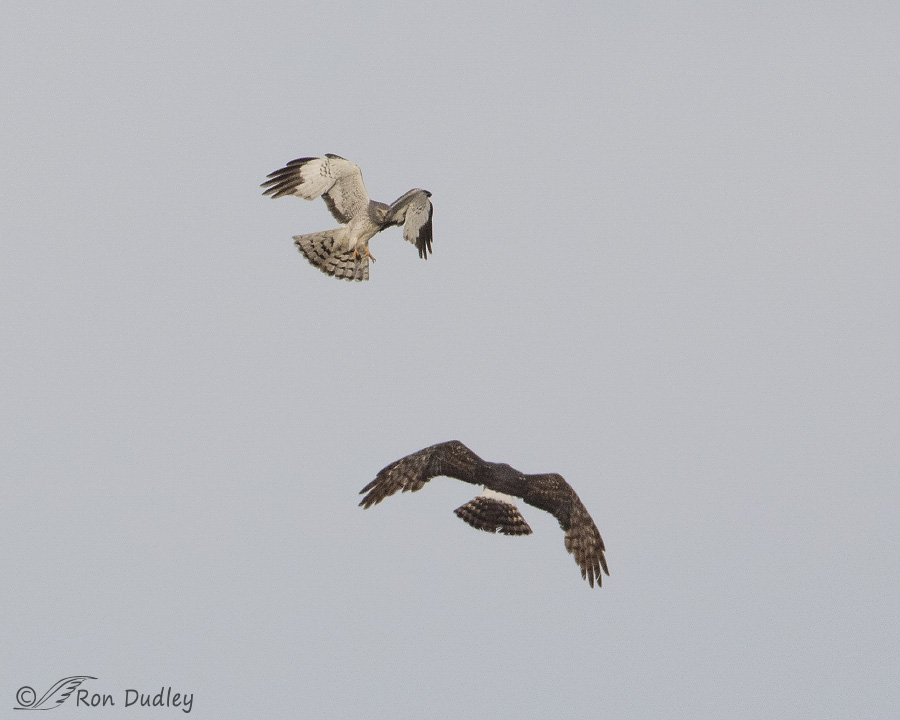
1/2500, f/6.3, ISO 800, Canon 7D Mark II, Canon EF 500mm f/4L IS II USM + 1.4 tc, not baited, set up or called in
Here the darker female at bottom has left the nest and is approaching the food-bearing male. The food item, in the right foot of the male, appears to be an already half-eaten vole so it’s quite small.
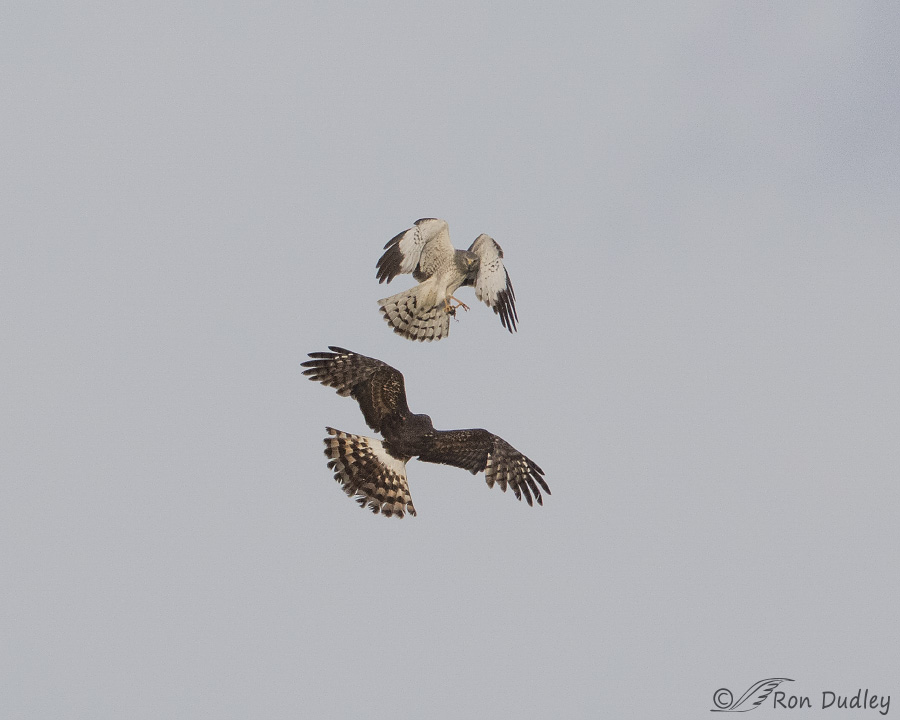
1/2500, f/6.3, ISO 800, Canon 7D Mark II, Canon EF 500mm f/4L IS II USM + 1.4 tc, not baited, set up or called in
As they approached each other the male prepared to drop the vole.
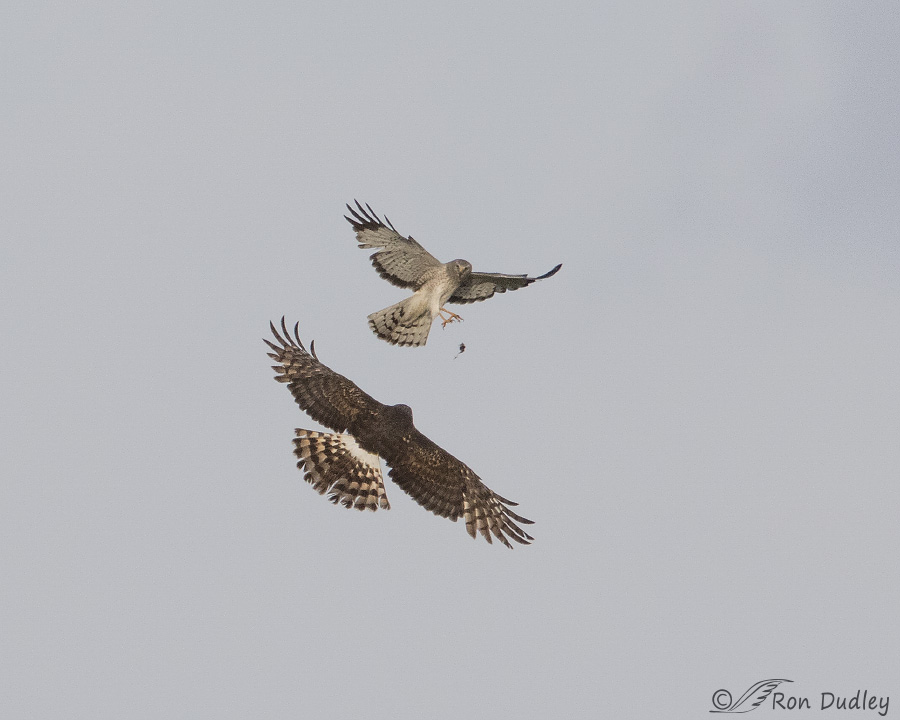
1/2500, f/6.3, ISO 800, Canon 7D Mark II, Canon EF 500mm f/4L IS II USM + 1.4 tc, not baited, set up or called in
Drop made. Now it’s the responsibility of the female to catch it.
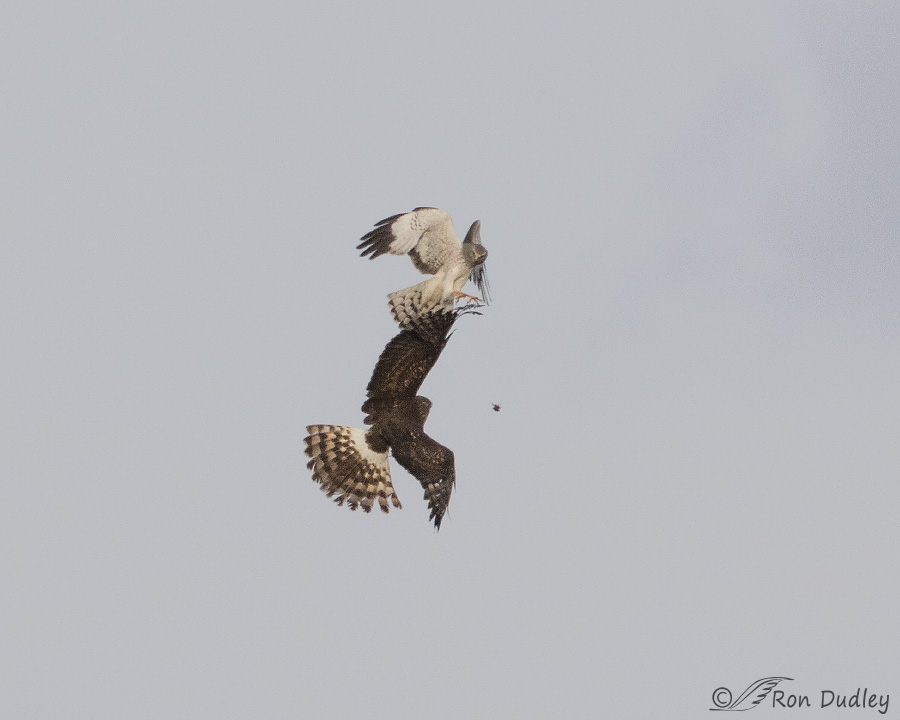
1/2500, f/6.3, ISO 800, Canon 7D Mark II, Canon EF 500mm f/4L IS II USM + 1.4 tc, not baited, set up or called in
She maneuvered to approach it…
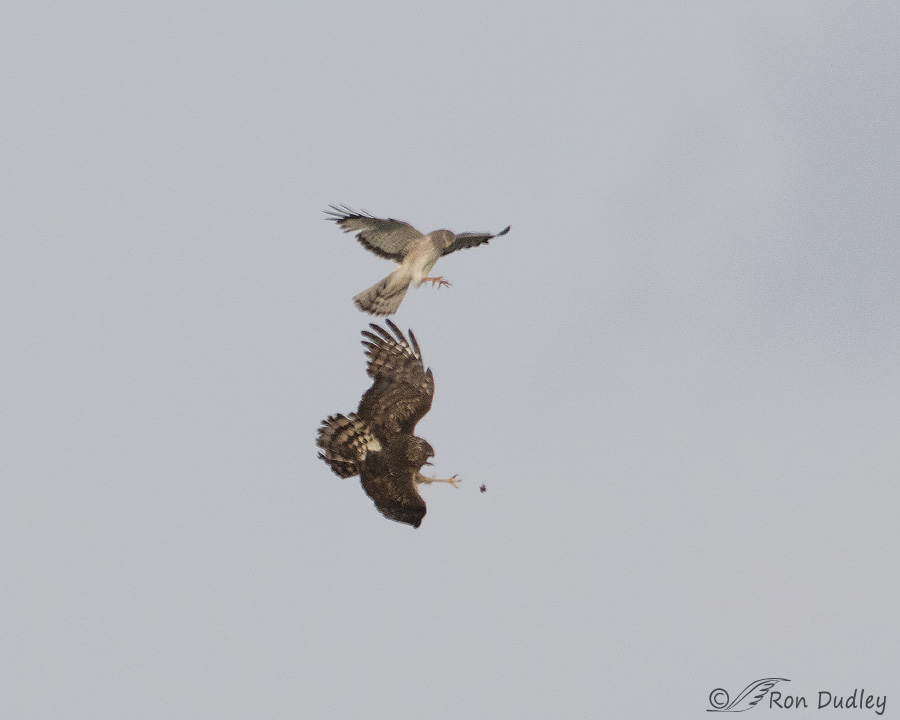
1/2500, f/6.3, ISO 800, Canon 7D Mark II, Canon EF 500mm f/4L IS II USM + 1.4 tc, not baited, set up or called in
reached out with her right foot…
This image is softer than the rest and I’m not sure why.
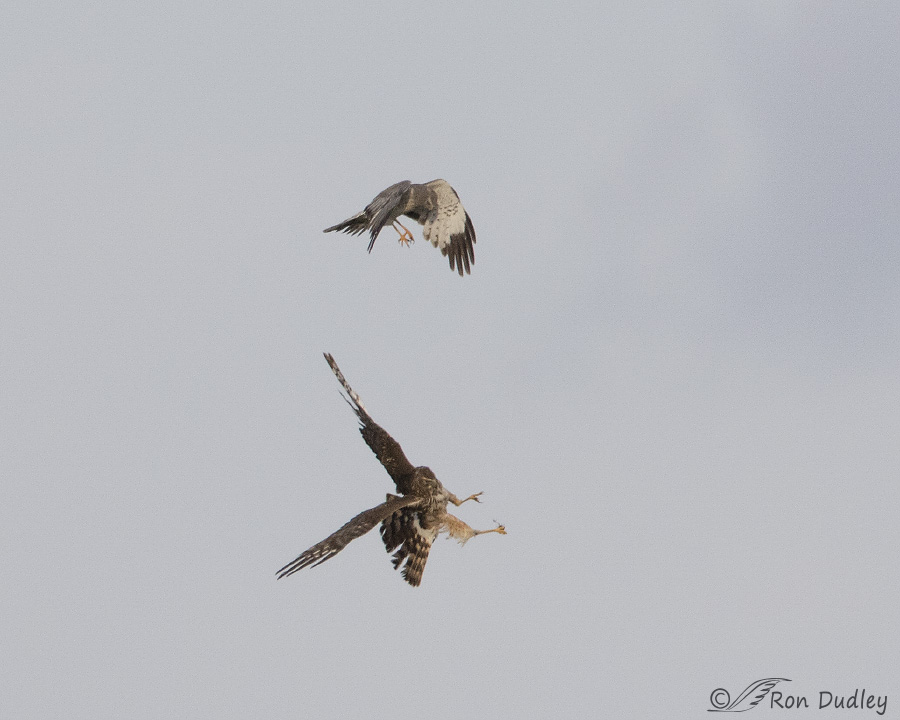
1/2500, f/6.3, ISO 800, Canon 7D Mark II, Canon EF 500mm f/4L IS II USM + 1.4 tc, not baited, set up or called in
and successfully snagged it.
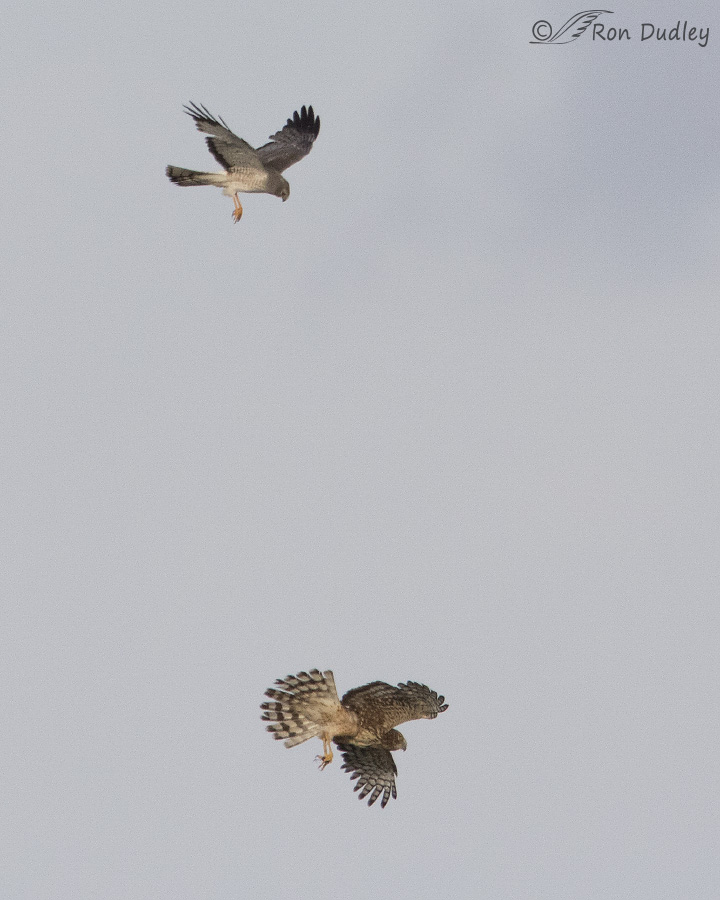
1/2500, f/6.3, ISO 800, Canon 7D Mark II, Canon EF 500mm f/4L IS II USM + 1.4 tc, not baited, set up or called in
Then the male presumably went back to more hunting and the female returned to the nest.
I’ve been trying to photograph this food exchange for almost 9 years now and I’ve come quite close to success a few times but something has always gone wrong. This time most things came together except for one – distance from subjects. One day I hope to get quality photographs of the behavior from a closer distance but for now this series will have to do.
Ron


Fantastic! I’d love to see this some day! Thank you so much.
just another WOW! What an incredible series.
So – the juveniles “playing catch” with cow chips and other small things is practice for an adult skill that is critical in nesting success. I was wrong in thinking that is was just play. These are great photos. I really like the one with her talon out reaching toward the prize.
Ahh, you apparently remember my post about harriers playing catch with cow chips, Pam. That made me smile.
Play is often, maybe usually, preparatory for “real life”…
WOW! You’ve outdone yourself with these awesome behavioral shots Ron! CONGRATS!!
Charlotte
Oh dear god: you’ve done it again Ron: left me breathless. These are beyond gorgeous!
WOW, WOW and WOW.
How incredible to see. And what a complication to add to already difficult and challenging lives. If the female misses the catch who is responsible for collecting it again? Or does she miss out?
She’d likely miss out, EC, at least in this case. The nest is deep in the phrags (they’re flyng right over it) so the food would probably be lost.
Thanks very much for all the nice comments everyone. I’ve answered folks who have had questions but don’t have time today to respond to each comment individually. It’s certainly not because I don’t appreciate them though!
This is beautiful! Love it!!
What an incredible action to capture!!! I can’t imagine even being lucky enough to witness something like this, much less to actually capture it with your camera—WOW!!!
Absolutely amazing. Both the photos and the birds. Whew.
Takes my breath away! Even though the subjects are far away, the behavior is clearly captured! I will look for that behavior now! Thanks!
Very excited to see this happening. I almost felt like I was watching it in person. Thanks!!
Absolutely fascinating. Thank you!!!
Outrageously spectacular, Ron! I’ve never seen that behavior in real time.
I’d suspect from the size of the (leftover) critter that the nestlings are just newly hatched, but that said, Dad’s gotta eat, too. And by the redtail cam, the male often (but not always) eats the head and top part. That said, the off-with-their-head strategy works really well to stop that pesky struggling 🙂 Now that he’s bringing chipmunks to the nest of nearly-grown kiddos, he delivers them whole and they don’t go anywhere near as far as they did in the first week.
I wonder if they’re similar to the redtails in that he sometimes spells her during the incubation phase? See how one answer brings up a whole bunch of new questions? I love it when that happens.
“I wonder if they’re similar to the redtails in that he sometimes spells her during the incubation phase?”
Laura, BNA Online says that only the female incubates though the male may occasionally shade or guard the clutch for up to 5 minutes in the absence of the female.
Very interesting, Ron.
There was a discussion for a while about male redtails having a brood patch (sorry, but redtails have been my focus). It was said that they didn’t, but then we got a photo of Ezra’s brood patch to go along with my observation that Jack (male HH) having a brood patch every year. It was also said that male redtails don’t participate in the incubation and we found that not to be true, either. I’m guessing the male might participate more than in known, but that’s just another one of my GUESSES.
But I neglected to say how outrageous it is that you got these photos! Just another case of being in the right place at the right time with the right equipment, AND (here’s a biggie) the knowledge to use it along with the strength of soul to keep searching for these routinely spectacular shots! It’s pretty rare to get all those elements together at the same time! And you’ve got ’em all!
Incredible photos!
Wow! Two amazing feats- her capturing the vole and you capturing the images. Thanks again, Ron!
That’s an interesting exchange. Is this the only hawk to do this?? Your pics look pretty good on my cell 😎
Linda, as far as I know harriers are the only hawks that do this habitually.
Here is another one, Ron….Wow!!!
Yes WOW is right. Its an amazing picture!!!!! And your series is educational as well. Harriers are really a challenge for me to photograph. I see lots in winter but non in summer. Any ideas why?? Plus the 6.3 worked. Is it because of distance?
Marina, I’d only be guessing as to why you don’t see them in summer. Maybe not preferable habitat for nesting???
Yes, it’s because of distance. You have more depth of field the further your subject is from you and these harriers were a long distance away.
Congratulations on your own impressive “snag” ! Like several others, I’m wondering why this behavior developed ? Must serve some evolutionary advantage, but what
could it be ?
I don’t care how far away…these are good images of a very rare event that you captured beautifully…way to go Ron! Something I’ve never seen or even heard of, you just keep on teaching us about these wonderful creatures!
This series is just amazing! It makes me glad I’m not a Northern Harrier, because I’d probably starve to death. That feat takes a great deal of coordination. Thanks for posting it.
That is pure amazing!
Very nice Ron! I love the look on the male’s face that appears be encouraging to the female of “hear you go, make sure you catch this”. I will have to watch for this. I have seen the female come up from a nesting area to a male, however I was never able to see any transfer take place.
Ron – Thank you! Great shots, very difficult to take as well as you did (correct shutter speed, f/stop, ISO, exposure compensation, and just getting everything into the lens). Great behavior. Thanks.
Wow! What a great series. I can’t believe their coordination in mid air. Well done.
Great show even at a distance. Have admit that I have never seen this behavior before, have seen both males and females hunting, but never have found a nest.
Interesting that the male doesn’t come to the nest. Is it because they nest on the ground and his coming there would advertise the nest? Must be some evolutionary reason for their behavior. Any ideas?
“Interesting that the male doesn’t come to the nest. Is it because they nest on the ground and his coming there would advertise the nest? Any ideas?”
It could be that Dick, and it could also be that it gives the female a break from incubating and allows her some exercise. I’m just speculating though…
Wow! Great behavior capture! 🙂 Wonder why he doesn’t just bring it to the nest. Of course, she may be interested in some exercise after “sitting” 🙂
What a great series Ron. I had no idea they did this. Thank you for the photos and the lesson…very much appreciated 🙂
Hi Ron. Greetings
Thank you for documenting this behaviour.
Wow…I have never seen this before. Thanks Ron!
I’m glad you enjoyed it, Jean. Thanks.